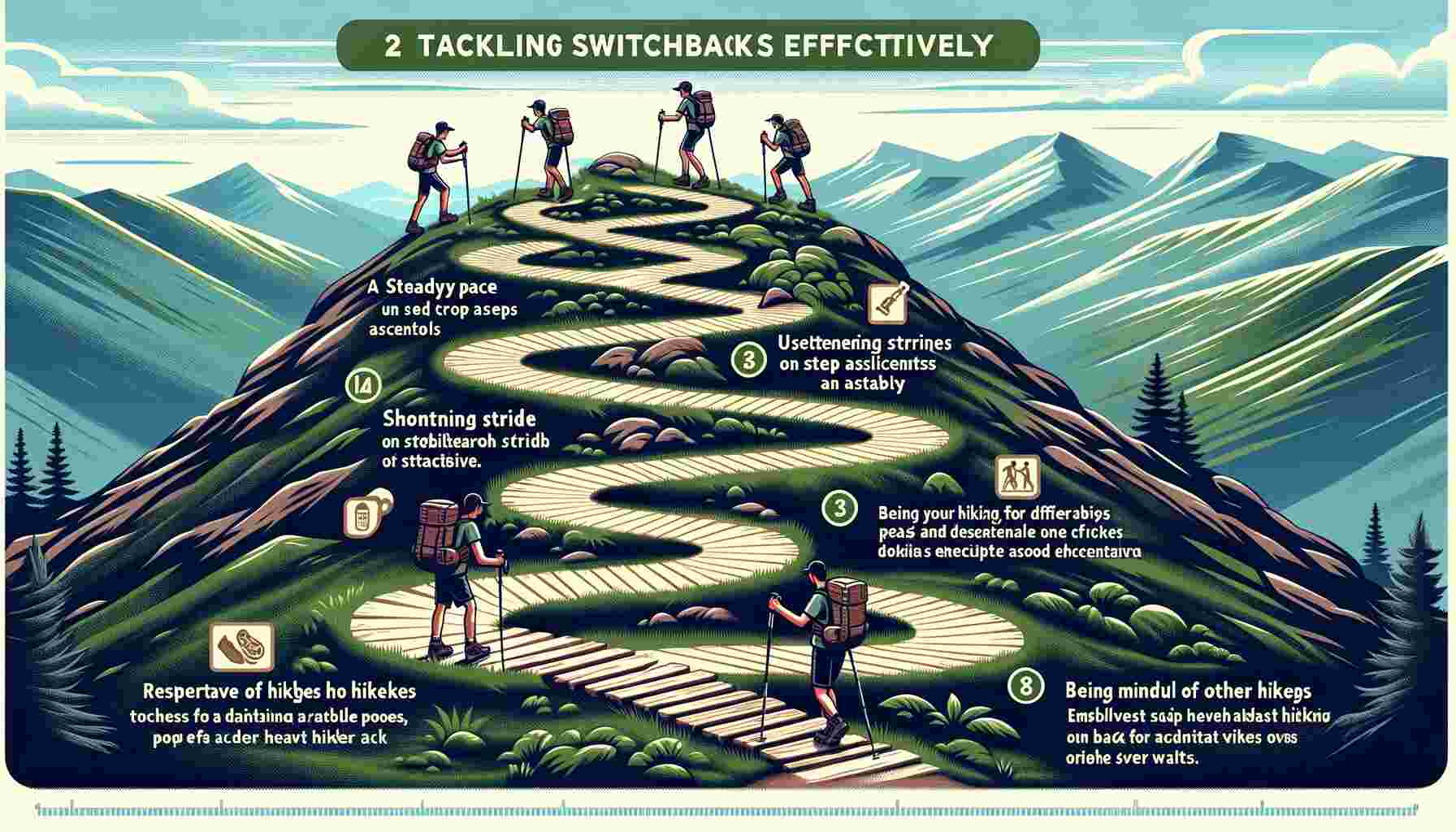Hiking is a fantastic way to connect with nature, challenge yourself physically, and enjoy the great outdoors. However, as any seasoned hiker will tell you, not all trails are created equal. Some routes take you through steep, winding paths that can leave even the most experienced hiker breathless – both in awe of the scenery and from the physical exertion required. These paths are often filled with switchbacks, a unique feature of many mountainous trails.
What Are Switchbacks?
Switchbacks are ingeniously designed elements of hiking trails that address the challenges of steep terrains, offering a strategic approach to ascent and descent. These zig-zag pathways ingeniously transform what would be a daunting vertical climb into a manageable, gradual slope. This approach not only enhances the hiking experience by reducing physical strain but also plays a pivotal role in preserving the trail’s integrity and the surrounding natural environment.
Benefits for Hikers
- Ease of Hiking: By breaking down a steep incline into a series of manageable segments, switchbacks make the once formidable task of mountain climbing accessible to many. This gradual approach allows hikers to maintain a steady pace without overexerting themselves.
- Safety: The design of switchbacks minimizes the risk of accidents. Steep, direct ascents, or descents increase the likelihood of slips and falls. By offering a gentler slope, switchbacks significantly reduce these hazards, contributing to a safer hiking environment.
Benefits for the Environment
- Erosion Control: One of the critical environmental benefits of switchbacks is their role in combating erosion. Steep slopes are particularly susceptible to erosion, exacerbated by foot traffic which can strip away vegetation and soil. Switchbacks help distribute the force of foot traffic more evenly, reducing the impact on any single point along the path.
- Preservation of Natural Vegetation: By minimizing the area of disturbance, switchbacks help preserve the natural vegetation around the trail. This preservation is crucial for maintaining biodiversity, soil stability, and the overall health of the ecosystem.
- Sustainability: Beyond erosion control, the thoughtful design of switchbacks contributes to the broader sustainability of outdoor recreation areas. They ensure that trails remain viable and enjoyable for future generations by minimizing the adverse effects of human activity on the natural landscape.
Design and Implementation
Switchbacks are typically employed on terrains with a gradient steeper than 15 percent. The design standards for these pathways aim to balance usability and environmental impact, with approach legs often featuring an 8% to 10% linear grade and a cross-slope of around 5%. This careful planning ensures that the trails are accessible while maintaining natural terrain integrity.

Tips for Tackling Switchbacks Effectively
Now that you understand what switchbacks are and why they are used, let’s explore how to tackle them effectively. Hiking switchbacks can be physically demanding, but with the right techniques and mindset, you can conquer even the steepest trails.
1. Maintain a Steady Pace
When hiking switchbacks, it’s essential to find a pace that you can maintain comfortably. Trying to rush up or down the turns can lead to exhaustion quickly. Remember that hiking is not a race; it’s about enjoying the journey and the scenery. A steady pace will help you conserve energy for the entire hike.
2. Use Proper Footwear and Proper Foot Placement
Wearing appropriate hiking boots with good traction is crucial when tackling switchbacks. The terrain can be uneven and steep, so having the right footwear will provide stability and reduce the risk of slipping. Proper Foot Placement: Ensure your feet are firmly planted with each step to maintain balance and prevent slipping on uneven terrain.
3. Shorten Your Stride
On steep ascents, it’s beneficial to shorten your stride. This will give you better control over your movements and reduce the strain on your leg muscles. Shorter steps also allow for better balance on uneven terrain.
4. Maintain Good Posture
Proper posture is key to conserving energy and preventing injury. Keep your back straight, shoulders relaxed, and your center of gravity low. Leaning forward slightly can help you maintain balance on steep ascents.
5. Use Hiking Poles
Trekking poles can be a valuable asset when hiking switchbacks. They provide additional stability, distribute your weight more evenly, and reduce the strain on your knees and joints especially on descents.
6. Take Short Breaks
Don’t hesitate to take short breaks between switchbacks if needed. Catch your breath, hydrate, and enjoy the scenery. These breaks can help you recharge and stay motivated throughout your hike.
7. Hydrate and Snack
Staying hydrated and maintaining your energy levels is essential during any hike, but especially when tackling switchbacks. Carry enough water and some energy-boosting snacks to keep you going.
8. Uphill vs. Downhill Technique
The approach to switchbacks differs when ascending and descending:
- Ascending: Lean into the hill slightly to maintain balance. Take short, deliberate steps, and use your core and leg muscles to propel yourself upward.
- Descending: Lean back slightly to distribute your weight and reduce the risk of falling forward. Take smaller steps, and use trekking poles to provide stability.
9. Respect the Trail
Always stay on the designated trail, even if it seems tempting to cut corners or take shortcuts. Straying off-trail can cause damage to the environment and lead to further erosion.
10. Be Mindful of Others
If you encounter fellow hikers on switchbacks, be courteous and yield the trail to those going uphill. Uphill hikers often have a harder time maintaining their momentum, so giving them the right of way is a common practice in hiking etiquette.
The Psychological Aspect of Tackling Switchbacks
Hiking switchbacks isn’t just a physical challenge; it can also test your mental resilience. The continuous zigzagging can sometimes feel like you’re making slow progress, which can be mentally taxing. Here are some psychological strategies to help you stay motivated:
Set Milestones
Break the switchbacks into smaller, manageable sections and set milestones for yourself. Knowing that you’ve reached a specific point can provide a sense of accomplishment and motivation to continue.
Focus on the Scenery
Switchbacks often offer stunning views of the surrounding landscape. Use these moments to appreciate the beauty of nature and distract yourself from physical exertion.
Positive Self-Talk
Maintain a positive mindset by using self-encouragement. Remind yourself of your capabilities and the satisfaction you’ll feel when you reach the summit or complete the trail.
Hiking with a Group
Hiking with friends or a group can provide motivation and support. Sharing the experience and encouraging each other can make tackling switchbacks more enjoyable.
Common Mistakes to Avoid
While tackling switchbacks, it’s crucial to avoid some common mistakes that hikers often make.
Cutting Switchbacks
Cutting across switchbacks instead of following the designated path can cause soil erosion and damage the trail. Always stay on the established route to protect the environment.
Overpacking
Carrying unnecessary weight can make switchbacks even more challenging. Pack only the essentials and keep your backpack as light as possible.
Ignoring Weather Conditions
Weather conditions can change rapidly in mountainous terrain. Be prepared for sudden changes and check the weather forecast before starting your hike.
Pushing Beyond Your Limits
Know your physical limitations and don’t push yourself too hard. If you start feeling unwell or exhausted, it’s okay to turn back or take a break.
Navigational Strategies
- Observation and Planning: Before embarking on your hike, study the trail map to familiarize yourself with the switchback sections. This preparation can help you anticipate changes in the trail’s direction and ensure you remain on the correct path.
- Environmental Respect: Stick to the marked trail to avoid creating new paths or exacerbating soil erosion. Venturing off the designated trail can damage the ecosystem and lead to hazardous conditions for you and future hikers.
Statistics
In 2023, hiking saw a significant resurgence in popularity, with about 24% of tourists including it in their travel plans. This revival follows a downturn in tourism during 2020 due to the pandemic. Notably, Kilimanjaro National Park witnessed a substantial increase in visits, climbing from 12,100 in 2020 to 47,200 in 2023, nearing its peak visitation in 2012.
These statistics reflect a growing interest in outdoor activities and the enduring appeal of hiking as a way to explore natural beauty and challenge oneself physically
FAQs on Hiking Switchbacks
Q1: Can switchbacks be found in all types of hiking trails?
Switchbacks are primarily used in trails with steep terrain to manage the ascent and descent more effectively. While they are common in mountainous areas, not all trails will have switchbacks, especially those in flat or gently rolling landscapes.
Q2: Are there any specific techniques for hiking switchbacks in snowy or icy conditions?
In snowy or icy conditions, it’s crucial to have the right gear, such as microspikes or crampons, and trekking poles for added stability. Take shorter, more deliberate steps to maintain balance, and be especially cautious on the turns where ice can accumulate.
Q3: How do switchbacks affect the total distance of a hike?
Switchbacks increase the total distance of a hike because the trail zigzags across the terrain, making the path longer than a direct ascent or descent. This design helps manage the trail’s steepness, making it more accessible.
Q4: What should I do if I encounter wildlife while hiking on switchbacks?
If you encounter wildlife, keep your distance, make your presence known in a calm manner, and never feed or attempt to touch the animals. Follow local guidelines for specific wildlife you might encounter, such as bears or snakes.
Q5: How can I tell if a trail will have switchbacks before I start my hike?
Many trail guides and maps will indicate the presence of switchbacks, especially if they’re a significant feature of the hike. Researching your trail online or consulting with local hiking organizations can also provide this information.
Q6: What is the best way to practice for hiking on switchbacks?
Practicing on stairs or using a stair climber machine can help simulate the continuous ascent or descent of switchbacks. Incorporating hill training into your routine can also prepare your muscles for the unique demands of switchback hiking.
Q7: Are switchbacks only used in hiking trails, or do they have other applications?
While this guide focuses on hiking, switchbacks are also utilized in mountain biking, skiing, and even in road construction to manage steep gradients more effectively, ensuring safety and accessibility.
Q8: How do I handle switchbacks on a mountain bike?
Mountain biking on switchbacks requires controlling your speed, using your brakes effectively, and positioning your body to manage the turns. Practice on easier switchbacks to build your skills before tackling more challenging trails.
Q9: Can hiking on switchbacks contribute to altitude sickness?
Hiking at high elevations, including trails with switchbacks, can contribute to altitude sickness if you ascend too quickly. It’s important to acclimatize properly and recognize the symptoms of altitude sickness early.
Q10: Are there environmental concerns specific to hiking on switchbacks?
Sticking to the trail is crucial in switchback areas to prevent soil erosion and protect vegetation. Creating shortcut paths, or “cutting switchbacks,” can damage the environment and lead to trail degradation.
Conclusion
In conclusion, switchbacks in hiking are a trail design technique that involves a series of sharp, alternating turns, cutting sharply from one direction to the other while ascending or descending a steep hill or mountainside. These zigzagging turns serve to gradually reduce the gradient of the trail, enhancing safety, and manageability for hikers, and minimizing environmental impact by preventing soil erosion.
Switchbacks are more than just a trail feature; they are a symbol of the balance between the thrill of exploration and the responsibility of conservation.
The next time you encounter a switchback on your hike, embrace it as an opportunity to engage with the environment thoughtfully and enjoy the unique vistas and experiences it offers.










